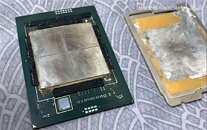Monday, May 3rd 2021

Intel "Sapphire Rapids" Xeon Processor Could Feature Up To 80 Cores: New Leak
Intel's upcoming Xeon "Sapphire Rapids" enterprise processor come come with CPU core-counts as high as 80, according to the latest round of photo-leaks. An earlier article predicted the chip cram up to 56 cores alongside on-package HBM. The processor reportedly features up to 80 cores, spread across four 20-core chiplets. Unlike on the latest AMD EPYC processor, there doesn't appear to be a centralized I/O controller die. This particular processor is based in the LGA4189 package, which features additional pins compared to the LGA4577-X socket from the 56-core leak. The newer socket has additional pins that enable next-gen I/O, which include PCI-Express Gen 5.0, and CXL 1.1 interface.
Source:
HotHardware

36 Comments on Intel "Sapphire Rapids" Xeon Processor Could Feature Up To 80 Cores: New Leak
If i follow your Logic , ICL-SP is 56 core instead 40
And Skylake SP is 36 core not 28 ....
GPUs are a completely different model of computation. CPUs are low latency, GPUs are high latency. It takes extraordinary amounts of effort to rewrite code to efficiently work on a GPU, and its unknown if some algorithms could ever be efficient on a GPU.
EDIT: If you mean a 60-core CPU-card that plugs into the PCIe port, well, that was already done. Look up Xeon Phi 5110P, no one seemed to like it.
It can happen. Just really unlikely. And if it does happen, the end result won't really look like a truck fundamentally anymore, and more like a jet-plane.
----------
Ex: PEZY Accelerators are CPU-like and GPU-like (en.wikichip.org/wiki/pezy/pezy-scx/pezy-sc). But as a hybrid design, they don't look anything like a traditional CPU or GPU: clearly some kind of weird mix between the two. The A64Fx is another hybrid: mostly CPU (ARM architecture), but it uses GPU-RAM instead of traditional CPU-RAM.
I expect future CPUs to grow more GPU-like, and for future GPUs to grow more CPU-like. But at the same time, there's clearly "CPU-only" workloads and "GPU-only" workloads. Some tasks may never make sense on the other architecture.